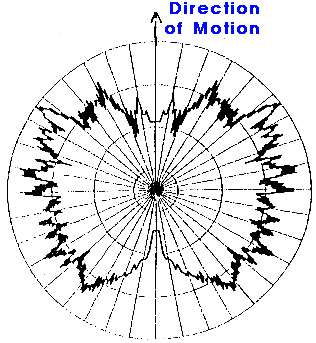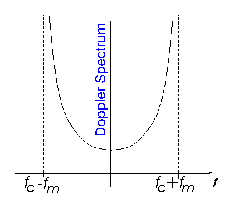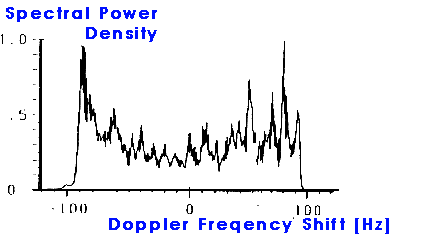
 |
JPL's Wireless Communication Reference WebsiteChapter: Wireless Channels
|

The Doppler shift of this wave is
![]() ,
,
where v is the speed of the antenna.
The maximum Doppler shift occurs for a wave coming from the opposite direction as the direction the antenna is moving to. It has a frequency shift
v
fm = -- fc
c
|

|
Such motion of the antenna leads to (time varying) phase shifts of individual reflected waves. It is not so much this minor shift that bothers radio system designers, as a receiver oscillator can easily compensate for it. Rather, it is the fact that many waves arrive, all with different shifts. Thus, their relative phases change all the time, and so it affects the amplitude of the resulting composite signal. So the Doppler effects determine the rate at which the amplitude of the resulting composite signal changes.

Figure (on the right): Distribution of angle of arrival in a typical urban propagation situation. Measurement at 1800 MHz. Source: Research group of Prof. Paul Walter Baier, U. of Kaiserslautern, Germany.
This leads to the U-shaped power spectrum for isotropic scattering,
1 1
S(f) = -------- ---------------------
4 p fm (f-fc)2
sqrt( 1 - -------)
fm2
where we assumed a unity local mean power.
 Figure: Power density spectrum of a sine wave suffering from a Doppler spread. | 
|

Figure: Measured Doppler spread at 1800 MHz. Doppler spread = 60.3 Hz Source: Research group of Prof. Paul Walter Baier, U. of Kaiserslautern, Germany. See also: full scatter plot. |
If a sinusoidal signal is transmitted (represented by a spectral line in the frequency domain), after transmission over a fading channel, we will receive a power spectrum that is spread according to the above image. The frequency range where the power spectrum is nonzero defines the Doppler spread.
The Doppler spread is relevant, for instance to compute threshold crossing rates and average fade durations.
| System | Countermeasure | ||
| Analog | Doppler causes random FM modulation which may be audible. Carrier frequency is low enough to avoid problems | ||
| GSM |
| ||
| DECT |
| ||
| IS95 Cellular CDMA |
| ||
| Wireless LAN's | Mobility is slow, thus Doppler spread is only a few Hertz |